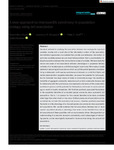A new approach to interspecific synchrony in population ecology using tail association
| dc.contributor.author | Ghosh, S | |
| dc.contributor.author | Sheppard, LW | |
| dc.contributor.author | Reid, Philip | |
| dc.contributor.author | Reuman, D | |
| dc.date.accessioned | 2022-02-25T13:54:55Z | |
| dc.date.issued | 2020-12 | |
| dc.identifier.issn | 2045-7758 | |
| dc.identifier.issn | 2045-7758 | |
| dc.identifier.uri | http://hdl.handle.net/10026.1/18857 | |
| dc.description.abstract |
<jats:title>Abstract</jats:title><jats:p>Standard methods for studying the association between two ecologically important variables provide only a small slice of the information content of the association, but statistical approaches are available that provide comprehensive information. In particular, available approaches can reveal <jats:italic>tail associations</jats:italic>, that is, accentuated or reduced associations between the more extreme values of variables. We here study the nature and causes of tail associations between phenological or population‐density variables of co‐located species, and their ecological importance. We employ a simple method of measuring tail associations which we call the <jats:italic>partial Spearman correlation</jats:italic>. Using multidecadal, multi‐species spatiotemporal datasets on aphid first flights and marine phytoplankton population densities, we assess the potential for tail association to illuminate two major topics of study in community ecology: the stability or instability of aggregate community measures such as total community biomass and its relationship with the synchronous or compensatory dynamics of the community's constituent species; and the potential for fluctuations and trends in species phenology to result in trophic mismatches. We find that positively associated fluctuations in the population densities of co‐located species commonly show asymmetric tail associations; that is, it is common for two species’ densities to be more correlated when large than when small, or vice versa. Ordinary measures of association such as correlation do not take this asymmetry into account. Likewise, positively associated fluctuations in the phenology of co‐located species also commonly show asymmetric tail associations. We provide evidence that tail associations between two or more species’ population‐density or phenology time series can be inherited from mutual tail associations of these quantities with an environmental driver. We argue that our understanding of community dynamics and stability, and of phenologies of interacting species, can be meaningfully improved in future work by taking into account tail associations.</jats:p> | |
| dc.format.extent | 12764-12776 | |
| dc.format.medium | Electronic-eCollection | |
| dc.language | en | |
| dc.language.iso | en | |
| dc.publisher | Wiley Open Access | |
| dc.subject | aphids | |
| dc.subject | copula | |
| dc.subject | interspecies synchrony | |
| dc.subject | match– | |
| dc.subject | mismatch hypothesis | |
| dc.subject | plankton | |
| dc.subject | tail association | |
| dc.title | A new approach to interspecific synchrony in population ecology using tail association | |
| dc.type | journal-article | |
| dc.type | Journal Article | |
| plymouth.author-url | https://www.webofscience.com/api/gateway?GWVersion=2&SrcApp=PARTNER_APP&SrcAuth=LinksAMR&KeyUT=WOS:000587693800001&DestLinkType=FullRecord&DestApp=ALL_WOS&UsrCustomerID=11bb513d99f797142bcfeffcc58ea008 | |
| plymouth.issue | 23 | |
| plymouth.volume | 10 | |
| plymouth.publication-status | Published | |
| plymouth.journal | Ecology and Evolution | |
| dc.identifier.doi | 10.1002/ece3.6732 | |
| plymouth.organisational-group | /Plymouth | |
| plymouth.organisational-group | /Plymouth/Faculty of Science and Engineering | |
| plymouth.organisational-group | /Plymouth/Faculty of Science and Engineering/School of Biological and Marine Sciences | |
| plymouth.organisational-group | /Plymouth/REF 2021 Researchers by UoA | |
| plymouth.organisational-group | /Plymouth/REF 2021 Researchers by UoA/UoA07 Earth Systems and Environmental Sciences | |
| plymouth.organisational-group | /Plymouth/Users by role | |
| plymouth.organisational-group | /Plymouth/Users by role/Academics | |
| dc.publisher.place | England | |
| dcterms.dateAccepted | 2020-08-04 | |
| dc.rights.embargodate | 2022-2-26 | |
| dc.identifier.eissn | 2045-7758 | |
| dc.rights.embargoperiod | Not known | |
| rioxxterms.versionofrecord | 10.1002/ece3.6732 | |
| rioxxterms.licenseref.uri | http://www.rioxx.net/licenses/all-rights-reserved | |
| rioxxterms.licenseref.startdate | 2020-12 | |
| rioxxterms.type | Journal Article/Review |


